Scenic hiking tours offer breathtaking views and unforgettable memories, but they also come with potential risks and hazards. Whether you’re an experienced hiker or a beginner, it’s crucial to prioritize trail adventure safety by carrying a well-stocked first aid kit. A first aid kit specifically designed for scenic hiking tours can provide you with the necessary tools to handle emergencies and unexpected situations.
Some hiking essentials like emergency preparedness, wilderness first aid, and safety supplies can prevent minor injuries from turning into major issues on the hiking trail. A first aid kit equipped with necessary hiking gear and survival equipment can also give you peace of mind and allow you to enjoy your hiking trip without worries.
Key Takeaways
- Carrying a well-stocked first aid kit for scenic hiking tours is crucial for trail adventure safety.
- Essential items to include in a first aid kit for scenic hiking tours include wilderness first aid, hiking essentials, survival equipment, and safety supplies.
Why First Aid Kits are Essential for Scenic Hiking Tours
Scenic hiking tours are an excellent way to explore the great outdoors and appreciate nature’s beauty. However, hiking trails can be unpredictable, and hikers can encounter various risks and emergencies. To ensure trail adventure safety, carrying a well-stocked first aid kit is essential.
First aid kits provide outdoor safety and emergency preparedness. In case of an accident or injury, a first aid kit can be the difference between life and death. It can help hikers treat wounds, stop bleeding, and reduce the risk of infection. Additionally, a well-equipped kit can provide relief for pain, inflammation, and allergies, among other health issues.
Scenic hiking tours often take hikers to remote locations, where medical assistance may not be immediately available. Therefore, it is critical to carry a first aid kit that includes wilderness first aid essentials, such as water purification tablets, emergency blankets, and signaling devices. These items can help hikers survive in the wilderness until help arrives.
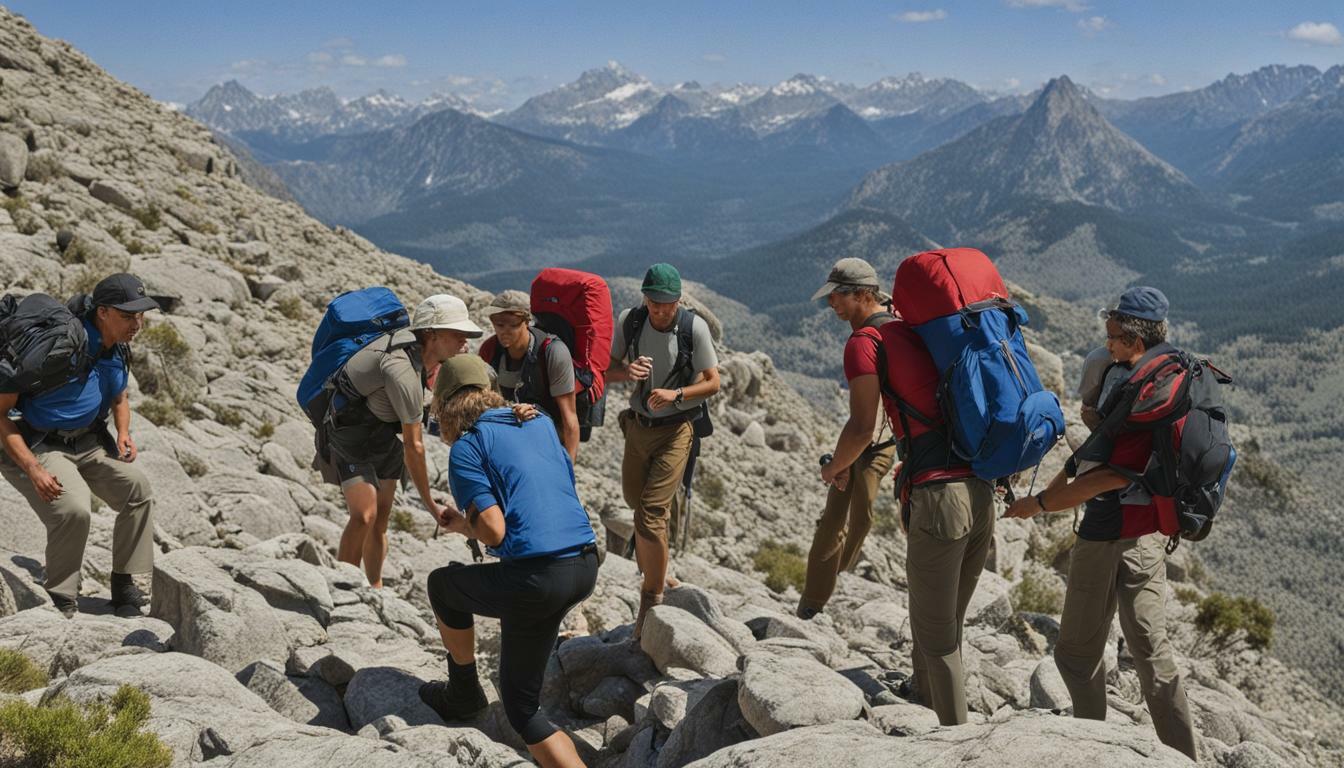
Furthermore, carrying a first aid kit demonstrates responsible hiking and trail adventure safety. Hikers who carry first aid kits show that they are prepared for any outdoor situation, and they prioritize the safety and well-being of themselves and their peers. It is always better to err on the side of caution and carry a first aid kit, even if there are no anticipated risks or emergencies.
In summary, first aid kits are essential for scenic hiking tours and outdoor safety. They provide emergency preparedness, wilderness first aid, and demonstrate responsible hiking. In the next section, we will discuss how to choose the right first aid kit for scenic hiking tours.
Choosing the Right First Aid Kit for Scenic Hiking Tours
When it comes to choosing a first aid kit for your scenic hiking tour, it’s essential to consider the specific needs of hiking. A well-stocked first aid kit can make a significant difference in an emergency situation, and it is one of the hiking essentials that hikers should never leave home without.
Opt for a first aid kit that includes wilderness first aid supplies such as gauze, adhesive bandages, antiseptics, wound dressings, and pain relief medication. It’s also crucial to have hiking-specific items such as blister treatments, tick removers, and emergency blankets. Consider the duration of your hiking trip and the number of individuals in your group, as this will help you determine the appropriate size and quantity of supplies needed for your first aid kit.
| Essential Items for a Scenic Hiking Tour First Aid Kit |
|---|
| Adhesive bandages of various sizes |
| Gauze and wound dressings |
| Antiseptics and antibiotic ointments |
| Pain relief medication such as ibuprofen and acetaminophen |
| Blister treatments |
| Tweezers and tick removers |
| Emergency blanket |
| Moleskin for foot care |
| Emergency whistle |
| Sunscreen and insect repellent |
Also, invest in quality hiking gear and survival equipment such as sturdy hiking boots, water bottles, headlamps, and a map and compass. These hiking essentials can prevent accidents and make your hiking trip more comfortable and enjoyable.
Lastly, don’t forget to pack safety supplies such as a personal locator beacon and a satellite phone for remote hiking trails. These additional measures can provide peace of mind and ensure you’re prepared for any outdoor situation.
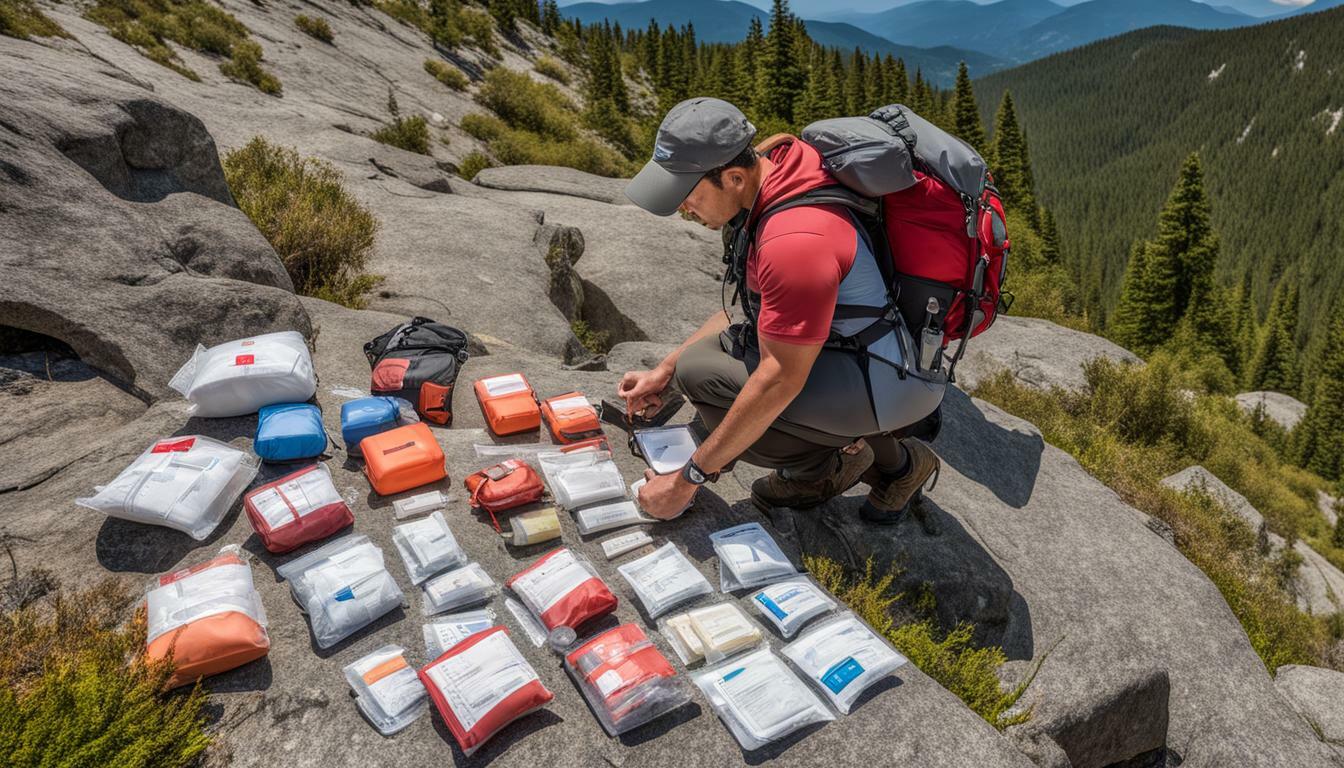
Packing Your First Aid Kit: Must-Have Items for Hiking Emergencies
Your first aid kit is an essential item for any scenic hiking tour. Here is a comprehensive list of must-have items to include in your kit for any hiking emergency:
| Item | Function |
|---|---|
| Bandages (various sizes) | To cover and protect wounds, as well as to wrap sprains and strains. |
| Antiseptics (e.g., alcohol wipes or hydrogen peroxide) | To clean wounds and prevent infections. |
| Pain relief medication (e.g., aspirin or ibuprofen) | To alleviate pain from injuries or headaches. |
| Tweezers | To remove splinters, thorns, or ticks. |
| Scissors | To cut clothing or bandages. |
| Triangular bandage | To use as a sling for arm or shoulder injuries. |
| CPR face shield or mask | To protect yourself when administering CPR. |
| Disposable gloves | To avoid direct contact with bodily fluids. |
| Emergency blanket | To prevent hypothermia or for shelter. |
| Water purification tablets | To treat contaminated water. |
| Emergency whistle | To signal for help. |
| Emergency contact information | To quickly and easily reach emergency services or loved ones. |
| Insect repellent | To prevent bug bites and related illnesses. |
| Sunscreen | To prevent sunburn and skin damage. |
| Blister treatment (e.g., moleskin or blister pads) | To protect and relieve pain from blisters. |
| Medications that you or your group members may need | To manage allergies, asthma, or other chronic medical conditions. |
Remember to regularly inspect your first aid kit before each scenic hiking tour to ensure that all items are up-to-date and well-stocked. Proper emergency preparedness can make all the difference in ensuring a safe and enjoyable trail adventure.
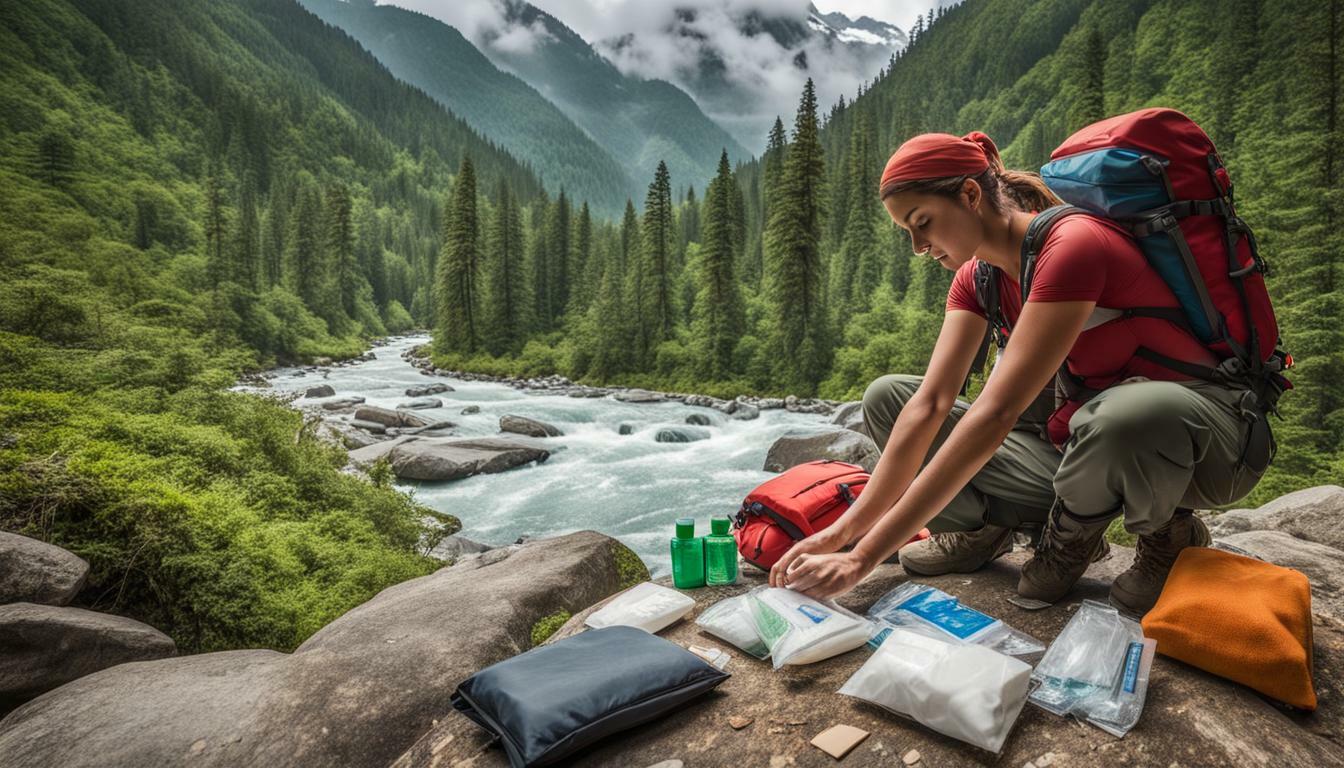
Additional Safety Measures for Scenic Hiking Tours
Aside from a well-stocked first aid kit, hikers should consider additional safety measures to ensure trail adventure safety and outdoor preparedness. Here are some recommendations:
Navigational Tools:
Carry a map and compass to navigate through unfamiliar terrain. Consider a GPS device or smartphone app as backup, but don’t rely on technology alone as batteries can die or signals can be lost.
Communication Devices:
Bring a whistle for signalling for help and a fully charged mobile phone, but keep in mind that coverage may not be available in remote areas. Consider a satellite phone or personal locator beacon (PLB) for added security.
Emergency Shelter:
Carry a lightweight emergency shelter (like a bivvy bag or tarp) in case of unexpected weather changes or if hikers need to stay overnight.
Leaving Trip Plans:
Inform a responsible person about the hiking plans, including the route, expected return time, and emergency contact information. Leave a note on the dashboard or at the hotel reception to indicate your whereabouts.
Survival Equipment:
Carry a multi-tool knife, fire starter kit, and extra food and water in case of emergency. Learn survival skills, such as creating a fire and building a shelter, to be self-sufficient in the wilderness.
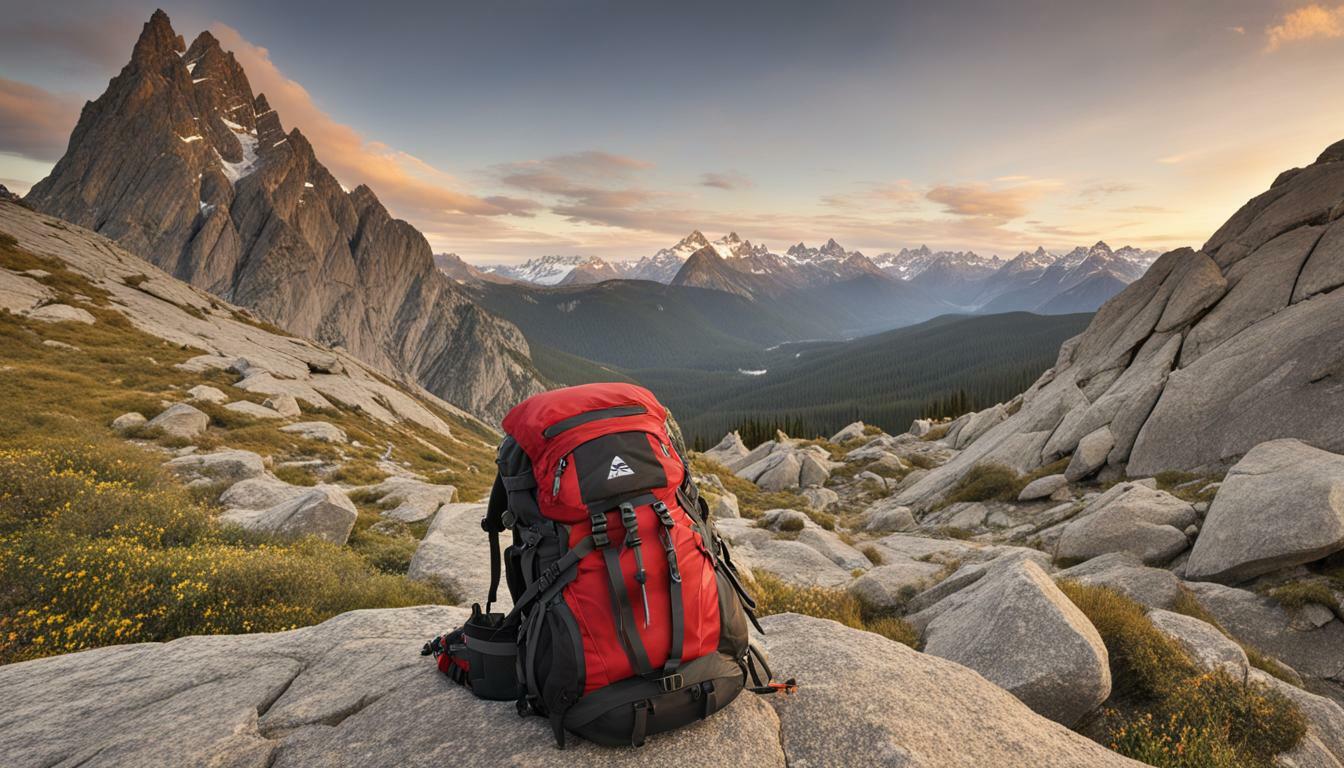
Remember that safety should always be the top priority when embarking on a scenic hiking tour. By taking these additional safety measures and carrying a well-stocked first aid kit, hikers can enjoy a fulfilling and worry-free outdoor adventure.
First Aid Training for Hiking Safety
While it’s important to have a well-stocked first aid kit, knowing how to use it effectively is equally vital. This is where wilderness first aid training comes into play.
Wilderness first aid prepares hikers to handle emergencies in remote locations, where medical assistance may be hours or even days away. It teaches you how to assess and manage injuries, illnesses, and other medical issues that may arise during a scenic hiking tour.
Some of the skills you will learn in wilderness first aid training include:
- Assessing an emergency situation
- Providing basic life support
- Treating injuries such as sprains, fractures, and dislocations
- Managing wounds and infections
- Recognising and treating altitude sickness, hypothermia, and dehydration
- Administering medication and pain relief
By acquiring these skills, you will be better equipped to handle unexpected situations on a scenic hiking tour. Moreover, you’ll feel more confident and prepared to explore the great outdoors.
There are numerous wilderness first aid courses available, ranging from basic to advanced levels. Some organisations even offer courses specifically tailored to hiking safety. Research local course providers and select a trusted and reputable one that meets your needs.
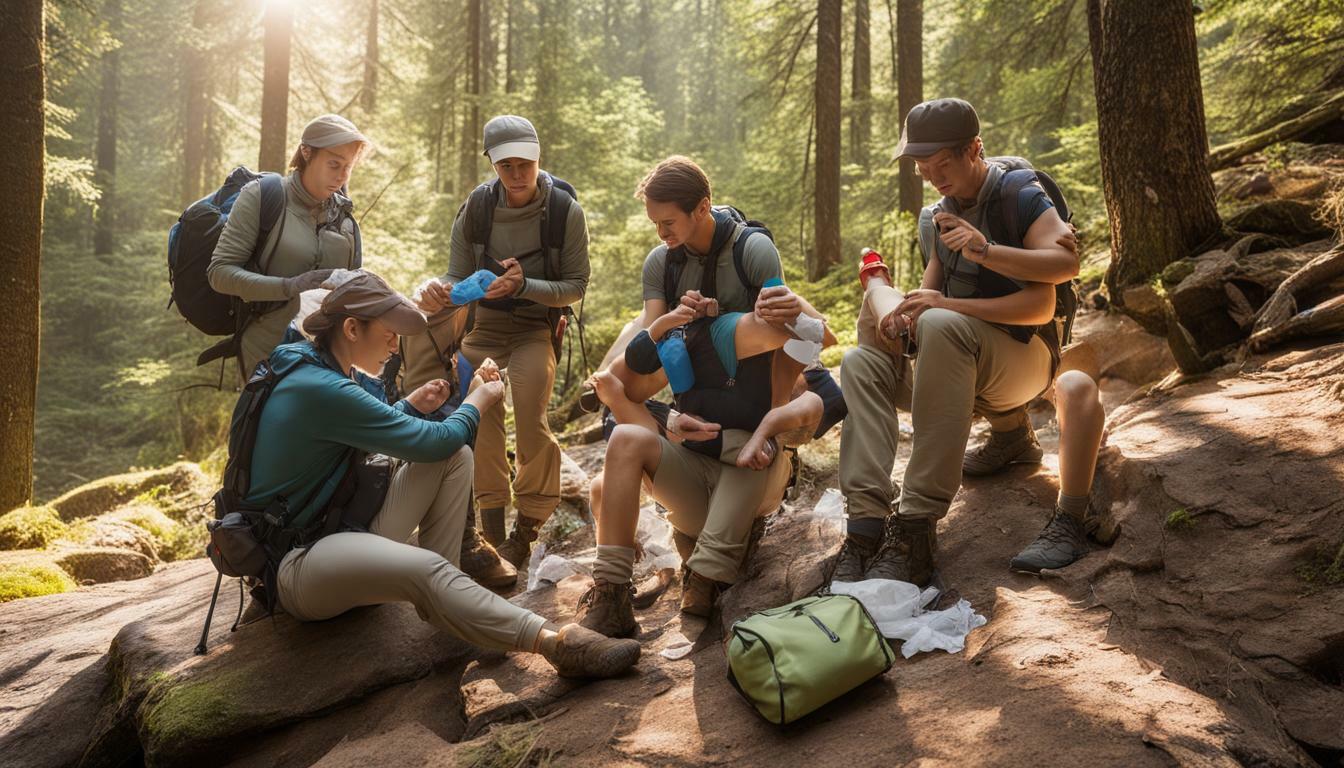
Remember, prevention is always better than cure. But in situations where medical assistance is not readily available, being equipped with wilderness first aid knowledge can be a lifesaver.
Maintaining Your First Aid Kit and Staying Prepared
It’s essential to keep your first aid kit up to date to ensure you’re prepared for any trail adventure safety situation during your scenic hiking tours. Regular inspections of your kit will help you identify items that need to be replaced.
As you inspect your kit, check the expiry dates of all medications and ointments. Make sure you replace any expired items and ensure that you have enough supplies for your next hike.
Replenishing your kit with the necessary outdoor safety supplies is equally important as well. Whether you need blister treatments, sun protection, or insect repellents, ensure that your kit has all the essentials for your hiking adventure.
If you’ve used any items from your kit during your hiking trip, make sure to replace them before your next adventure. This ensures that your kit has everything it needs in case of an emergency. By maintaining your first aid kit, you’ll be able to stay prepared for any outdoor safety situation.

Don’t forget to check the weather, and pack your kit accordingly. In colder temperatures, you may need additional items like a thermal blanket or heat packs while warmer conditions may require additional sun protection.
Staying vigilant and keeping your kit prepared is vital for your trail adventure safety during scenic hiking tours.
Online Resources and Expert Recommendations for Hiking Safety
Staying safe on scenic hiking tours requires more than just a well-stocked first aid kit. That’s why we recommend taking advantage of online resources and expert recommendations to enhance your trail adventure safety. A quick search online can lead you to reputable websites, blogs, and forums that offer valuable insights and tips on hiking safety, gear, and accessories.
One such website is Hiking Gear Lab, a platform that provides in-depth reviews and recommendations on hiking gear and safety supplies. You can also check out Hiking For Her, a blog by Diane Spicer, a veteran hiker with decades of experience in trail adventure safety.
If you’re looking for a community of like-minded hikers, visit the subreddit /r/hiking on Reddit. A vast network of hikers shares their experiences, tips, and advice on this platform. You can also find local hiking groups on Meetup.com.
Finally, don’t forget to consult with experts in wilderness first aid and safety training. Wilderness Medical Associates International (WMA) is a leading provider of wilderness first aid courses across the UK. These courses can equip you with essential knowledge and skills to handle emergencies effectively during your scenic hiking tour.

Trail Adventure Success Stories: Real-Life Examples
There is nothing quite like the feeling of conquering a scenic hiking tour. The fresh air, stunning views, and sense of accomplishment make it an experience like no other. However, as we’ve discussed throughout this article, outdoor safety should always be a top priority.
Real-life trail adventure success stories highlight the importance of preparedness and the role a well-stocked first aid kit plays in outdoor safety. For example, Sarah was on a scenic hiking tour when she slipped on a rock and twisted her ankle. Thanks to her first aid training and preparedness, she was able to immobilize her ankle and administer appropriate first aid care until help arrived.
Similarly, Tom was on a multi-day hiking tour when he developed blisters on his feet. Thanks to the blister treatments and bandages he had packed in his first aid kit, he was able to continue the tour without any discomfort.
These real-life examples demonstrate that prioritizing trail adventure safety can make all the difference in enjoying a successful hiking experience. So, take the time to educate yourself on wilderness first aid and ensure that you have a well-stocked first aid kit packed for your next scenic hiking tour.
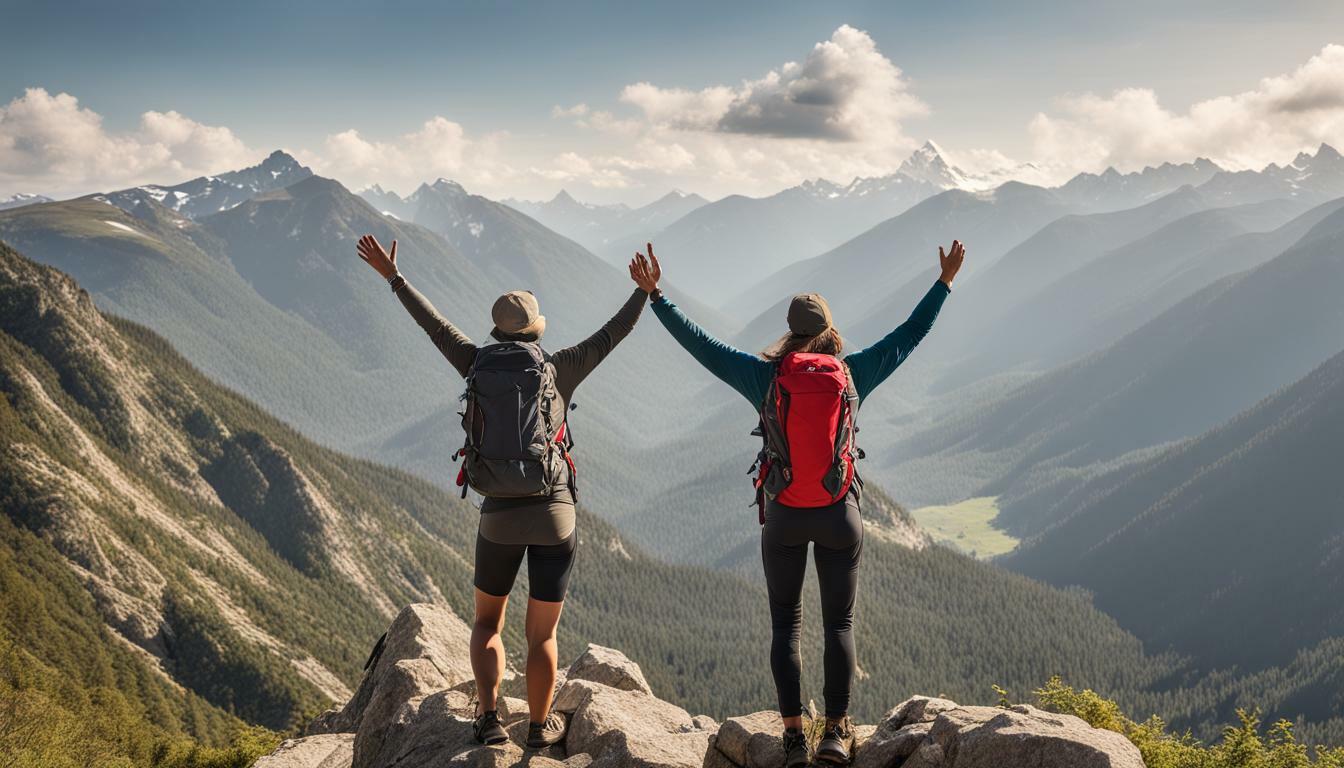
Conclusion
Scenic hiking tours offer a unique opportunity to explore and appreciate the great outdoors. However, it is crucial to prioritize trail adventure safety to ensure a successful and enjoyable excursion.
Carrying a well-equipped first aid kit is a crucial aspect of outdoor safety, providing essential items for wound care, pain relief and other hiking-specific necessities such as blister treatments and tick removers. Choosing the right first aid kit for scenic hikes and packing it with must-have items for hiking emergencies can help mitigate potential risks and ensure preparedness for any situation that may arise.
In addition to carrying a first aid kit, hikers should also consider other safety measures such as navigation tools, communication devices and emergency shelter. Acquiring first aid training, such as wilderness first aid courses, can also empower hikers to handle emergencies effectively.
Regular inspections, expiration date checks and replenishing supplies are essential to maintain a well-stocked first aid kit and stay prepared at all times. Additionally, seeking expert recommendations and learning from the success stories of other hikers can also enhance trail adventure safety.
Remember, carrying a first aid kit and prioritizing outdoor safety is not only beneficial to you but also to others around you. We encourage all hikers to prioritize trail adventure safety and stay prepared for any outdoor situation.
